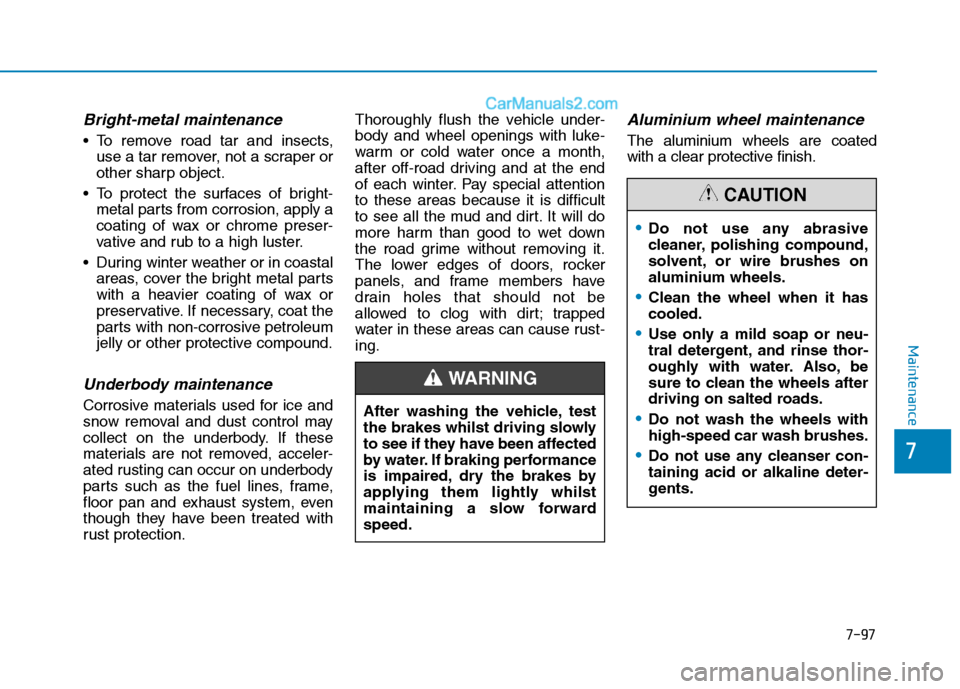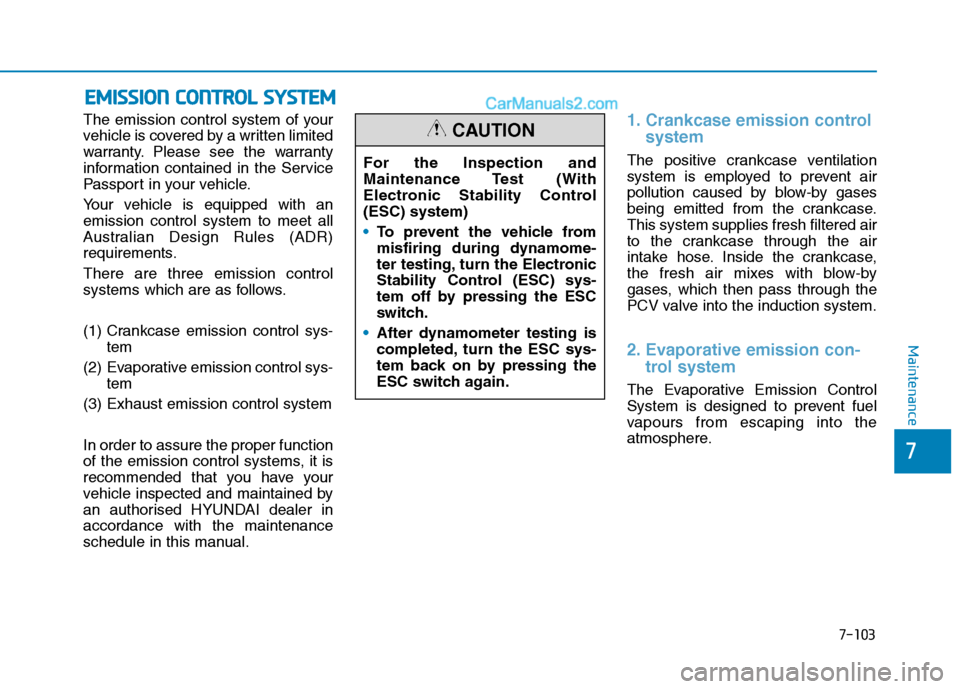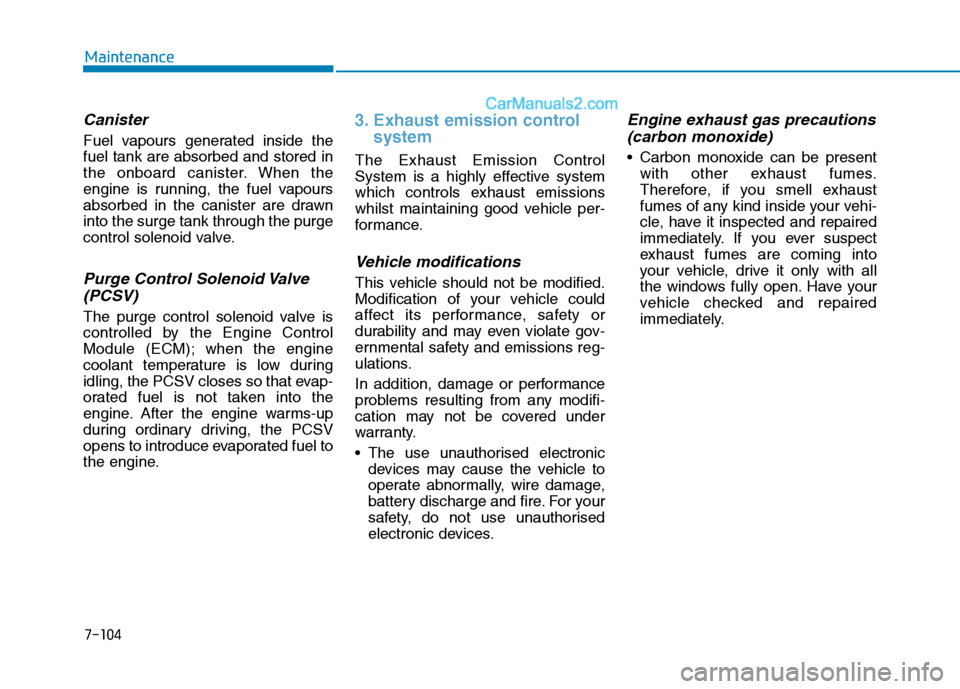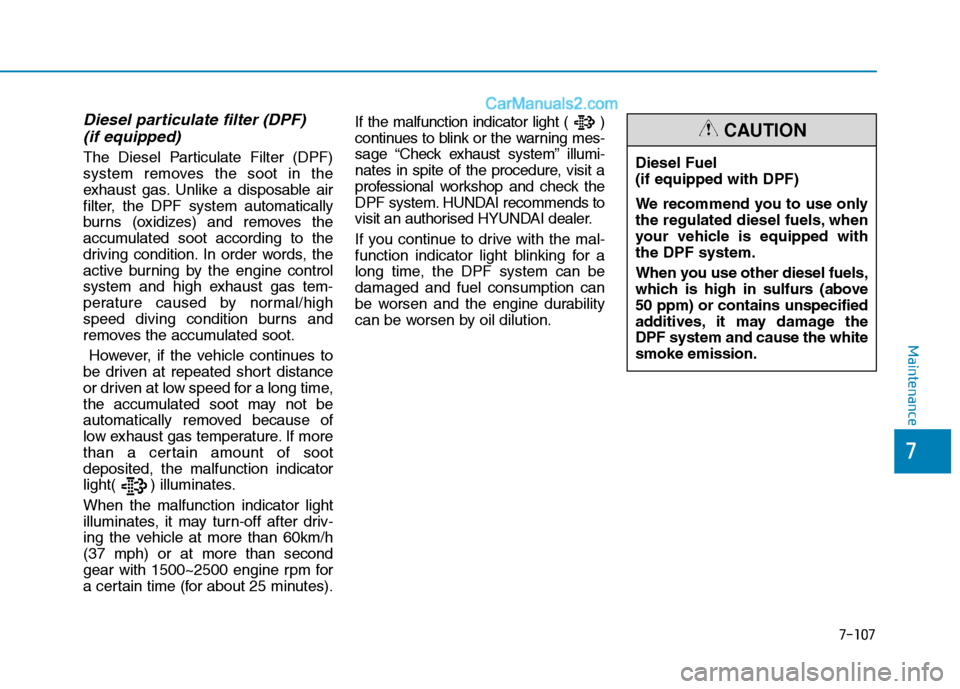Page 595 of 637
7-79
7
Maintenance
Fuse Name SymbolFuse ratingCircuit Protected
FUSE
BLOWER 40A E/R Junction Block (RLY. 13)
T/GATE OPEN 40A Power Tailgate Module
FUEL FILTER
HEATER 30A [D4HA] E/R Junction Block (RLY. 10)
REAR
HEATED 40A E/R Junction Block (RLY. 2)
MULTI
FUSE-2
(D4HA)
GLOW 80A Glow Relay Unit
PTC
HEATER 1 50A E/R Junction Block (RLY. 6)
PTC
HEATER 2 50A E/R Junction Block (RLY. 5)
PTC
HEATER 3 50A E/R Junction Block (RLY. 4)
Page 596 of 637
7-80
Maintenance
Fuse Name SymbolFuse ratingCircuit Protected
FUSE
DCU 3DCU315A Not Used
DCU 2DCU220A Not Used
DCU 1DCU120A Not Used
WIPER 125A [W/O Smart Key] Ignition Switch, [With Smart Key] PDM (IG2) Relay
TCU 115A PCM/ECM/TCM
ECU 320A [G4NA/G4FJ] PCM/ECM
HORN15A Horn Relay
BATTERY
MANAGEMENT10A Not Used
SENSOR 210A
[G4NA] Oil Control Valve #1/#2, Variable Intake Solenoid Valve,
Camshaft Position Sensor #1/#2, Purge Control Solenoid Valve,
E/R Junction Block (RLY. 1, RLY. 3)
[G4FJ] Oil Control Valve #1/#2, Purge Control Solenoid Valve,
RCV Control Solenoid Valve, E/R Junction Block (RLY. 1, RLY. 3)
[D4HA] Crankshaft Position Sensor, EGR Cooling Bypass Solenoid Valve,
Stop Lamp Switch, E/R Junction Block (RLY. 3, RLY. 6)
SENSOR 115A [G4NA/G4FJ] Oxygen Sensor (Up/Down)
[D4HA] Lambda Sensor #1/#2, Electronic VGT Actuator, Fuel Pressure Regulating
Valve, PM (Particulate Matter) Sensor, E/R Junction Block (RLY. 1)
Page 597 of 637
7-81
7
Maintenance
Fuse Name SymbolFuse ratingCircuit Protected
FUSE
ECU 220A [G4NA] Ignition Coil #1/#2/#3/#4, Condenser
[G4FJ] Ignition Coil #1/#2/#3/#4
[D4HA] ECM
ECU 515A [G4FJ] ECM
[D4HA] TCM
ECU 415A [G4FJ] PCM/ECM
[G4NA/D4HA] ECM
SENSOR 310A [G4NA] Injector #1/#2/#3/#4
[G4FJ] ECM
[D4HA] Mass Air Flow Sensor, Oil Pump Solenoid Valve
DEICER15A E/R Junction Block (RLY. 8 - Front Deicer Relay)
FUEL PUMP 120A E/R Junction Block (RLY. 14)
MODULE 17.5A [D4HA] Glow Relay Unit, Fuel Filter Warning Sensor
B/A HORN10A E/R Junction Block (RLY. 7 - B/A Horn Relay)
ABS 310A ESC Control Module
Page 613 of 637

7-97
7
Maintenance
Bright-metal maintenance
To remove road tar and insects,
use a tar remover, not a scraper or
other sharp object.
To protect the surfaces of bright-
metal parts from corrosion, apply a
coating of wax or chrome preser-
vative and rub to a high luster.
During winter weather or in coastal
areas, cover the bright metal parts
with a heavier coating of wax or
preservative. If necessary, coat the
parts with non-corrosive petroleum
jelly or other protective compound.
Underbody maintenance
Corrosive materials used for ice and
snow removal and dust control may
collect on the underbody. If these
materials are not removed, acceler-
ated rusting can occur on underbody
parts such as the fuel lines, frame,
floor pan and exhaust system, even
though they have been treated with
rust protection.Thoroughly flush the vehicle under-
body and wheel openings with luke-
warm or cold water once a month,
after off-road driving and at the end
of each winter. Pay special attention
to these areas because it is difficult
to see all the mud and dirt. It will do
more harm than good to wet down
the road grime without removing it.
The lower edges of doors, rocker
panels, and frame members have
drain holes that should not be
allowed to clog with dirt; trapped
water in these areas can cause rust-
ing.
Aluminium wheel maintenance
The aluminium wheels are coated
with a clear protective finish.
After washing the vehicle, test
the brakes whilst driving slowly
to see if they have been affected
by water. If braking performance
is impaired, dry the brakes by
applying them lightly whilst
maintaining a slow forward
speed.
WARNING
Do not use any abrasive
cleaner, polishing compound,
solvent, or wire brushes on
aluminium wheels.
Clean the wheel when it has
cooled.
Use only a mild soap or neu-
tral detergent, and rinse thor-
oughly with water. Also, be
sure to clean the wheels after
driving on salted roads.
Do not wash the wheels with
high-speed car wash brushes.
Do not use any cleanser con-
taining acid or alkaline deter-
gents.
CAUTION
Page 619 of 637

7-103
7
Maintenance
E EM
MI
IS
SS
SI
IO
ON
N
C
CO
ON
NT
TR
RO
OL
L
S
SY
YS
ST
TE
EM
M
The emission control system of your
vehicle is covered by a written limited
warranty. Please see the warranty
information contained in the Service
Passport in your vehicle.
Your vehicle is equipped with an
emission control system to meet all
Australian Design Rules (ADR)
requirements.
There are three emission control
systems which are as follows.
(1) Crankcase emission control sys-
tem
(2) Evaporative emission control sys-
tem
(3) Exhaust emission control system
In order to assure the proper function
of the emission control systems, it is
recommended that you have your
vehicle inspected and maintained by
an authorised HYUNDAI dealer in
accordance with the maintenance
schedule in this manual.1. Crankcase emission control
system
The positive crankcase ventilation
system is employed to prevent air
pollution caused by blow-by gases
being emitted from the crankcase.
This system supplies fresh filtered air
to the crankcase through the air
intake hose. Inside the crankcase,
the fresh air mixes with blow-by
gases, which then pass through the
PCV valve into the induction system.
2. Evaporative emission con-
trol system
The Evaporative Emission Control
System is designed to prevent fuel
vapours from escaping into the
atmosphere. For the Inspection and
Maintenance Test (With
Electronic Stability Control
(ESC) system)
To prevent the vehicle from
misfiring during dynamome-
ter testing, turn the Electronic
Stability Control (ESC) sys-
tem off by pressing the ESC
switch.
After dynamometer testing is
completed, turn the ESC sys-
tem back on by pressing the
ESC switch again.
CAUTION
Page 620 of 637

7-104
Maintenance
Canister
Fuel vapours generated inside the
fuel tank are absorbed and stored in
the onboard canister. When the
engine is running, the fuel vapours
absorbed in the canister are drawn
into the surge tank through the purge
control solenoid valve.
Purge Control Solenoid Valve
(PCSV)
The purge control solenoid valve is
controlled by the Engine Control
Module (ECM); when the engine
coolant temperature is low during
idling, the PCSV closes so that evap-
orated fuel is not taken into the
engine. After the engine warms-up
during ordinary driving, the PCSV
opens to introduce evaporated fuel to
the engine.
3. Exhaust emission control
system
The Exhaust Emission Control
System is a highly effective system
which controls exhaust emissions
whilst maintaining good vehicle per-
formance.
Vehicle modifications
This vehicle should not be modified.
Modification of your vehicle could
affect its performance, safety or
durability and may even violate gov-
ernmental safety and emissions reg-
ulations.
In addition, damage or performance
problems resulting from any modifi-
cation may not be covered under
warranty.
The use unauthorised electronic
devices may cause the vehicle to
operate abnormally, wire damage,
battery discharge and fire. For your
safety, do not use unauthorised
electronic devices.
Engine exhaust gas precautions
(carbon monoxide)
Carbon monoxide can be present
with other exhaust fumes.
Therefore, if you smell exhaust
fumes of any kind inside your vehi-
cle, have it inspected and repaired
immediately. If you ever suspect
exhaust fumes are coming into
your vehicle, drive it only with all
the windows fully open. Have your
vehicle checked and repaired
immediately.
Page 622 of 637

7-106
Maintenance
Your vehicle is equipped with a cat-
alytic converter emission control
device.
Therefore, the following precautions
must be observed:Failure to observe these precautions
could result in damage to the catalyt-
ic converter and to your vehicle.
Additionally, such actions could void
your warranties.
Use only UNLEADED FUEL
for petrol engine.
Do not operate the vehicle
when there are signs of
engine malfunction, such as
misfire or a noticeable loss of
performance.
Do not misuse or abuse the
engine. Examples of misuse
are coasting with the ignition
off and descending steep
grades in gear with the igni-
tion off.
Do not operate the engine at
high idle speed for extended
periods (5 minutes or more).
Do not modify or tamper with
any part of the engine or
emission control system. All
inspections and adjustments
must be made by an autho-
rised HYUNDAI dealer.
Avoid driving with a very low
fuel level. If you run out of
petrol, it could cause the
engine to misfire and result in
excessive loading of the cat-
alytic converter.
CAUTION
Page 623 of 637

7-107
7
Maintenance
Diesel particulate filter (DPF)
(if equipped)
The Diesel Particulate Filter (DPF)
system removes the soot in the
exhaust gas. Unlike a disposable air
filter, the DPF system automatically
burns (oxidizes) and removes the
accumulated soot according to the
driving condition. In order words, the
active burning by the engine control
system and high exhaust gas tem-
perature caused by normal/high
speed diving condition burns and
removes the accumulated soot.
However, if the vehicle continues to
be driven at repeated short distance
or driven at low speed for a long time,
the accumulated soot may not be
automatically removed because of
low exhaust gas temperature. If more
than a certain amount of soot
deposited, the malfunction indicator
light( ) illuminates.
When the malfunction indicator light
illuminates, it may turn-off after driv-
ing the vehicle at more than 60km/h
(37 mph) or at more than second
gear with 1500~2500 engine rpm for
a certain time (for about 25 minutes).If the malfunction indicator light ( )
continues to blink or the warning mes-
sage “Check exhaust system” illumi-
nates in spite of the procedure, visit a
professional workshop and check the
DPF system. HUNDAI recommends to
visit an authorised HYUNDAI dealer.
If you continue to drive with the mal-
function indicator light blinking for a
long time, the DPF system can be
damaged and fuel consumption can
be worsen and the engine durability
can be worsen by oil dilution.Diesel Fuel
(if equipped with DPF)
We recommend you to use only
the regulated diesel fuels, when
your vehicle is equipped with
the DPF system.
When you use other diesel fuels,
which is high in sulfurs (above
50 ppm) or contains unspecified
additives, it may damage the
DPF system and cause the white
smoke emission.
CAUTION